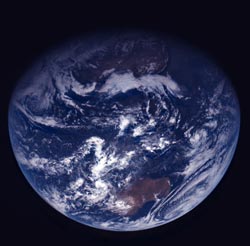Rosetta: Earth’s true colours

After its closest approach to Earth, Rosetta looked back and took a number of images using the OSIRIS Narrow Angle Camera (NAC). This particular image was acquired 15 November 2007 at 03:30 CET. The image is a colour composite of the NAC Orange, Green and Blue filters. At the bottom, the continent of Australia can be seen clearly. Credits: ESA ©2005 MPS for OSIRIS Team MPS/UPD/LAM/IAA/RSSD/INTA/UPM/DASP/IDA
The pictures were taken on 13 November during the swing-by, and on 15 November, as Rosetta left on its way to the outer Solar System, after the swing-by.
After its closest approach to Earth, Rosetta looked back and took a number of images using the Optical, Spectroscopic, and Infrared Remote Imaging System (OSIRIS) Narrow Angle Camera (NAC). This particular image was acquired 15 November 2007 at 03:30 CET.
The image above is a colour composite of the NAC orange, green and blue filters.
At the bottom, the continent of Australia can be seen clearly.
During the swing-by, OSIRIS observed Earth’s night-side.
This image shows a simulated view of Earth as seen from Rosetta's position.
The same view was seen by the OSIRIS Wide Angle Camera (WAC). It is shown in false colour to emphasise city lights seen at night.
This image was acquired on 13 November 2007 at 20:30 CET using the WAC with a red filter.
Media Contact
More Information:
http://www.esa.int/SPECIALS/Rosetta/SEMRYE63R8F_0.htmlAll latest news from the category: Physics and Astronomy
This area deals with the fundamental laws and building blocks of nature and how they interact, the properties and the behavior of matter, and research into space and time and their structures.
innovations-report provides in-depth reports and articles on subjects such as astrophysics, laser technologies, nuclear, quantum, particle and solid-state physics, nanotechnologies, planetary research and findings (Mars, Venus) and developments related to the Hubble Telescope.
Newest articles

Recovering phosphorus from sewage sludge ash
Chemical and heat treatment of sewage sludge can recover phosphorus in a process that could help address the problem of diminishing supplies of phosphorus ores. Valuable supplies of phosphorus could…

Efficient, sustainable and cost-effective hybrid energy storage system for modern power grids
EU project HyFlow: Over three years of research, the consortium of the EU project HyFlow has successfully developed a highly efficient, sustainable, and cost-effective hybrid energy storage system (HESS) that…

After 25 years, researchers uncover genetic cause of rare neurological disease
Some families call it a trial of faith. Others just call it a curse. The progressive neurological disease known as spinocerebellar ataxia 4 (SCA4) is a rare condition, but its…





















